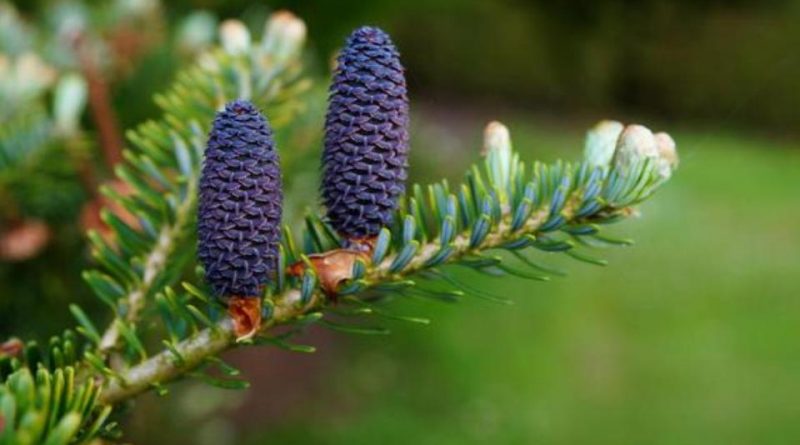Abies sibirica
Abies sibirica
The Siberian fir (Abies sibirica Ledeb.) Is an evergreen conifer belonging to the Pinaceae family.
Systematic –
From a systematic point of view, it belongs to the Eukaryota Domain, Plantae Kingdom, Pinophyta Division, Pinopsida Class, Pinales Order, Pinaceae Family and therefore to the Genus Abies and the Species A. sibirica.
The subspecies is present within the species: Abies sibirica subsp. semenovii (B.Fedtsch.) Farjon.
The terms are synonymous:
– Abies krylovii Golub;
– Abies pichta J.Forbes;
– Abies sibirica f. alpina Poljiakov;
– Abies sibirica var. alpina (Poljiakov ex Kom.) Silba;
– Abies sibirica f. alpina Poljiakov ex Kom.;
– Abies sibirica subsp. Sibirica;
– Picea pichta (J.Forbes) Loudon;
– Picea sibirica Gordon;
– Pinus pichta (J.Forbes) Fisch. ex Endl.;
– Pinus picea Pall..
Etymology –
The term Abies comes from Abies, classical Latin name (Virgil, Egloghe, from the Sanskrit root abh gush, for its resin.
The specific sibiric epithet as a plant of Siberian origin.
Geographical Distribution and Habitat –
Siberian fir is a conifer native to the taiga east of the Volga River and at latitude 67 ° 40 ‘, in the area of Turkestan, northeastern Xinjiang, Mongolia and Heilongjiang.
Its habitat is that of cold boreal climates on moist mountain soils or rivers at heights between 1900 and 2400 m. s.l.m., where it grows on alluvial, podzolic soils, also on calcareous soils, well drained and free from permafrost.
This fir can be found in pure but more often mixed forests in association with other conifers such as Picea obovata and Larix gmelinii, in mountain areas also with Larix sibirica and Pinus sibirica; it can also grow together with deciduous, also shrubby, such as Betula pendula, Populus tremula, Sorbus aucuparia and Viburnum opulus. In the south-western part of the area also with Tilia cordata, Ulmus scabra and Acer platanoides.
Description –
The Abies sibirica is a tree that can reach 30–35 m in height.
The trunk has diameters ranging from 0.5 to 1 m, at human height.
The crown assumes a conical shape.
The bark has variable colors from gray-green to gray-brown, smooth, with the presence of resin bubbles.
The buds are yellow-gray, resinous, and slightly pubescent.
The leaves are needles, ascending, on average 2–3 cm long and 1,5 mm wide; these are light gray in the upper part, with two white-gray stomatic bands at the bottom, soft, flattened, and very aromatic.
The pine cones have a cylindrical shape of 5 – 9.5 cm in length and 2.5–3.5 cm in width, with the presence of small bracts hidden by the scales.
The pine cones reach ripening in the autumn, with a gradual color change from bluish to brown, or dark brown.
The seeds are 7 mm long with a triangular winged part 0.7–1.3 cm long; after maturation these are released and fall to the ground.
Cultivation –
Siberian fir can be grown in cold climates where it prefers humid soils and preferably not very sunny areas.
It is a plant particularly resistant to shade and frost, tolerating temperatures down to -50 ° C. It rarely lives over 200 years due to its susceptibility to fungal decomposition in the wood.
Uses and Traditions –
Siberian fir is a tree widely used for its timber.
Wood is widely used in construction and in the preparation of cellulose pulp for the paper industry. In Central and Eastern Europe, several cultivars have been made for its use as an ornamental tree.
In addition, the essential oils extracted from the leaves are used in aromatherapy and perfumery.
It is in fact significantly exploited for this use and, to date, fortunately, despite intensive use, no specific and immediate risks have been identified for its survival. For this reason it is classified as a Least Concern species in the IUCN Red List.
Preparation method –
In addition to the uses for obtaining timber and for the extraction of essential oils in the field of aromatherapy and perfumery, this plant has no other pharmaceutical or food uses.
Guido Bissanti
Sources
– Acta Plantarum – Flora of the Italian Regions.
– Wikipedia, the free encyclopedia.
– Treben M., 2000. Health from the Lord’s Pharmacy, Tips and experiences with medicinal herbs, Ennsthaler Editore
– Pignatti S., 1982. Flora of Italy, Edagricole, Bologna.
– Conti F., Abbate G., Alessandrini A., Blasi C. (edited by), 2005. An annotated checklist of the Italian vascular flora, Palombi Editore.
Warning: Pharmaceutical applications and alimurgical uses are indicated for information purposes only, they do not in any way represent a medical prescription; therefore, no responsibility is accepted for their use for healing, aesthetic or food purposes.


